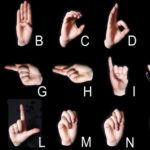Did you know that the sign languages used by people with hearing loss in England, Germany or Hungary are all different? In other words, deaf people in Japan, Hungary, Finnland, or the US use different signs. In addition, there is an international sign language, called Gestuno language, although, just like Esperanto, it is slow to spread. Moreover, sign languages also have dialects: in Hungary only, we distinguish a total of 7 dialects. There are language families, with different word order and grammar. And most surprisingly, there is sign language slang!
At first glance, all of this makes just about as much sense as having der/die/das in German: people simply chose to complicate their lives. But, in fact, these national sign languages have developed naturally, just like spoken languages and we have no explanation for this Babylonian Chaos.
A common basis for all sign languages is expressing an event through movement, somebody’s characteristic movement, or shape (e.g.: stir, boat, cradle, rock, be born, give birth). You also probably didn’t know that expressions used in sign languages are simplified, for example, a sentence such as ‘Tomorrow I will go to the shops and buy bread and milk.’ would sound something like this: ‘Tomorrow will go shop buy bread milk.’
Let’s not forget though that sign languages have some important rules too: you must be accurate in showing the sign, and gestures, facial expressions as well as posture are important parts of communication.
For better communication, people often articulate silently while signing. But even this needs to be done with care, the speaker needs to articulate more slowly than usual, without over-articulating, and can only use it to accompany signing.
And one more thing to remember: we sign, we do not gesticulate!
Written by Veronika Pataki, professionally supervised by Krisztina Koltai

